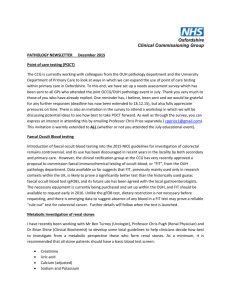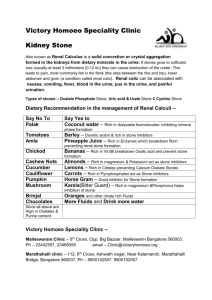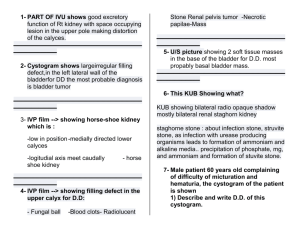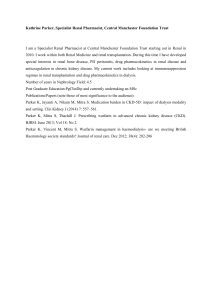Loin Pain (Renal Colic)
advertisement
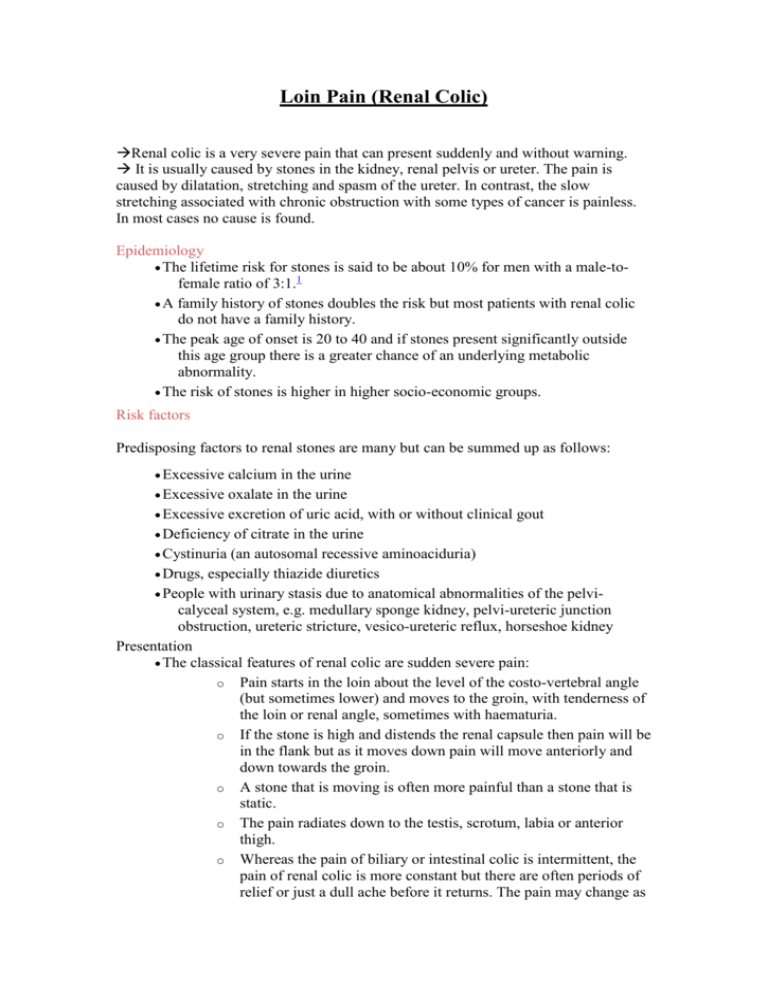
Loin Pain (Renal Colic) Renal colic is a very severe pain that can present suddenly and without warning. It is usually caused by stones in the kidney, renal pelvis or ureter. The pain is caused by dilatation, stretching and spasm of the ureter. In contrast, the slow stretching associated with chronic obstruction with some types of cancer is painless. In most cases no cause is found. Epidemiology The lifetime risk for stones is said to be about 10% for men with a male-tofemale ratio of 3:1.1 A family history of stones doubles the risk but most patients with renal colic do not have a family history. The peak age of onset is 20 to 40 and if stones present significantly outside this age group there is a greater chance of an underlying metabolic abnormality. The risk of stones is higher in higher socio-economic groups. Risk factors Predisposing factors to renal stones are many but can be summed up as follows: Excessive calcium in the urine Excessive oxalate in the urine Excessive excretion of uric acid, with or without clinical gout Deficiency of citrate in the urine Cystinuria (an autosomal recessive aminoaciduria) Drugs, especially thiazide diuretics People with urinary stasis due to anatomical abnormalities of the pelvicalyceal system, e.g. medullary sponge kidney, pelvi-ureteric junction obstruction, ureteric stricture, vesico-ureteric reflux, horseshoe kidney Presentation The classical features of renal colic are sudden severe pain: o Pain starts in the loin about the level of the costo-vertebral angle (but sometimes lower) and moves to the groin, with tenderness of the loin or renal angle, sometimes with haematuria. o If the stone is high and distends the renal capsule then pain will be in the flank but as it moves down pain will move anteriorly and down towards the groin. o A stone that is moving is often more painful than a stone that is static. o The pain radiates down to the testis, scrotum, labia or anterior thigh. o Whereas the pain of biliary or intestinal colic is intermittent, the pain of renal colic is more constant but there are often periods of relief or just a dull ache before it returns. The pain may change as the stone moves. The patient is often able to point to the place of maximal pain and this has a good correlation with the current site of the stone. There is usually associated nausea and often vomiting. There are often urinary symptoms that may be dysuria, frequency, oliguria and haematuria. There may be a previous history of renal colic. There may have been recent dehydration, including strenuous physical exercise or starting a drug that increases the risk. Examination The patient with colic of any sort writhes around in agony. This is in contrast to the patient with peritoneal irritation who lies still. The patient is apyrexial in uncomplicated renal colic (pyrexia suggests infection and the body temperature is usually very high with pyelonephritis). Examination of the abdomen will usually reveal tenderness over the affected loin. Bowel sounds may be reduced. This is common with any severe pain. There may be severe pain in the testis but the testis should not be tender. Blood pressure may be low. Full and thorough abdominal examination is essential to check for other possible diagnoses, e.g. acute appendicitis, ectopic pregnancy, aortic aneurysm. Investigations Urinalysis: o The stone often causes some bleeding into the renal tract and this may produce a positive result for blood on stick testing (a negative test does not exclude the diagnosis). If microscopy shows pyuria, this suggests infection. Check urine pH. pH above 7 suggests urea splitting organisms such as Proteus whilst a pH below 5 suggests uric acid stones. MSU for microscopy, culture and sensitivities Blood for renal function, electrolytes, calcium, phosphate and urate Encourage the patient to try to catch the stone for analysis. This may mean urinating through a tea strainer, filter paper such as a coffee filter or a gauze. Imaging of the urinary tract traditionally starts with a KUB x-ray. This is larger than the plain abdominal x-ray as it takes in both kidneys, ureters and bladder. Around 75% of stones are of calcium and so will be radio-opaque. Helical CT is now regarded as the gold standard for the investigation of urinary stones. Current guidance is that the best technique is unenhanced helical CT4 and CT is now the first line investigation in some hospitals, in order to avoid an accumulation of radiation which occurs if CT is performed only after an initial x-ray. Differential diagnosis This depends upon the position of the pain and the presence or absence or pyrexia. Biliary colic, usually from gall stones. Pain may radiate to the shoulder. There may be some jaundice and dark urine. Dissection of an aortic aneurysm: beware the patient who presents with features of renal colic for the first time over the age of 60. This may be dissection of aortic aneurysm leading to ruptured aortic aneurysm. Pyelonephritis: very high temperature. Pain unlikely to radiate to groin. Infection may co-exist. Acute pancreatitis: pain radiates to back. There tends to be epigastric or left upper quadrant pain and tenderness. Paralytic ileus may set in. Vomiting occurs early in the condition. Acute appendicitis: tender and guarding over McBurney's point. Possibly absent if posterior appendix. Any peritonism will cause lying still, not writhing. Perforated peptic ulcer: rigid abdomen; patient lies still. Epididymo-orchitis or torsion of testis: very tender testis. Sinister causes of back pain: usually tender over vertebrae. Drug addiction: There are reports of people with fictitious stories of renal colic, designed to obtain an injection of pethidine. These patients tend to be abusive when offered anything other than pethidine. Munchausen syndrome5 Management Medical assessment is advisable within 30 minutes of the onset of symptoms. Initial treatment Relief of pain must be an early priority. Traditionally pethidine has been used, with some people advocating diamorphine but intramuscular NSAID, usually in the form of diclofenac gives slightly better relief and is less likely to need repetition. This is supported by a Cochrane review that also noted that NSAIDs are less likely to cause nausea and vomiting that may well be a feature of the condition too.7 IM ketorlorac is an alternative but few GPs carry this whilst most carry parenteral diclofenac. If diclofenac is inadequate or contraindicated then morphine, diamorphine and pethidine are equally effective. The traditional view that pethidine is better at reliving spasm has not been substantiated. A Cochrane review concluded that if an opioid is used it should not be pethidine.7 An antiemetic may be required if there is severe nausea and vomiting, dehydration or an opioid is given. Avoid metoclopramide in young people in view of the risk of extrapyramidal side effects. Indications for hospital admission1 People who fail to respond to analgesia (see below) after 1 hour should be admitted to hospital (a second visit is not necessary, as assessment and admission can be done by telephone).6 People over the age of 60 years should be admitted if there are concerns on clinical condition or diagnostic certainty (a leaking aortic aneurysm may present with identical symptoms). Other indications for urgent admission include: o An abrupt recurrence of severe pain o Pain is persisting for more than 24 hours o Symptoms of systemic illness or infection; fever may suggest an infected obstructed kidney, which is a surgical emergency o Inability to take adequate fluids due to nausea and vomiting o Anuria o Known non-functioning kidney o Known solitary kidney o Pregnancy o Poor social support o Contact by telephone not possible o Inability to arrange early referral o Person's preference for admission o Need for assessment Conservative management6 All patients managed at home should drink a lot of fluids and, if possible, void urine into a container or through a tea strainer or gauze to catch any identifiable calculus. Analgesia; paracetamol is safe and effective for mild to moderate pain; codeine can be added if more pain relief is required. Paracetamol and codeine should be prescribed separately so they can be individually titrated.1 Tamsulosin may be useful during periods of watchful waiting to enhance ureteric stone expulsion.8 Patients should ideally receive an appointment for radiology within seven days of the onset of symptoms. An urgent urology outpatient appointment should be arranged for within one week if renal imaging shows a problem requiring intervention. Intervention options Urgent intervention is required for: o Obstructed and infected infected upper urinary tract o Impending renal deterioration o Intractable pain or vomiting o Anuria o Obstruction of a solitary or transplanted kidney Emergency drainage is achieved by placement of a nephrostomy catheter or ureteric stent. A JJ stent (called JJ stents because the top and bottom have a curled end to prevent migration of the stent) is sometimes used to relieve any urinary tract obstruction caused by the stone and to aid removal of the stone. Percutaneous nephrolithotomy (PCNL) is used for stones not suitable for ESWL (includes cystine stones, stones greater than 2 cm, and staghorn calculi) Complications Complete blockage of the urinary flow from a kidney decreases GFR and, if it persists for more than 48 hours, may cause irreversible renal damage. If ureteric stones cause symptoms after 4 weeks, there is a 20% risk of complications, including deterioration of renal function, sepsis, and ureteric stricture. Infection can be life threatening. Persisting obstruction predisposes to pyelonephritis. Prognosis1 Most symptomatic renal stones are small (less than 5 mm in diameter) and pass spontaneously. Stones larger than 1 cm in diameter usually require intervention (urgent intervention is required if complete obstruction or infection is present). A stone that has not passed within 1–2 months is unlikely to pass spontaneously. The following features predispose to recurrent stone formation: o First attack before 25 years of age o Single functioning kidney o A disease that predisposes to stone formation o Abnormalities of the renal tract Prevention If possible, risk factors should be addressed, but most important to prevent recurrence is maintenance of a good fluid intake to keep urine dilute.10 Avoid a diet high in salt or protein but do not advise a specific diet unless advised by a dietician. Do not restrict calcium intake.

